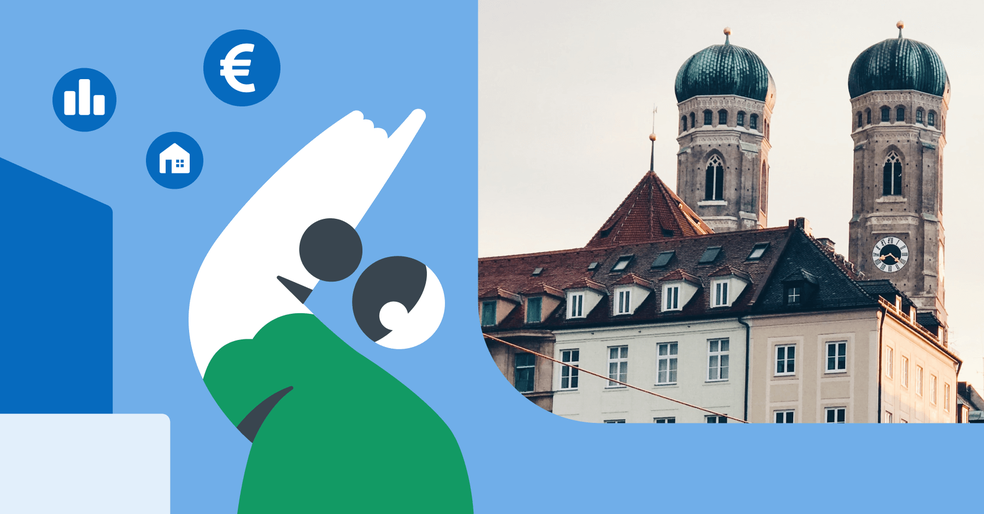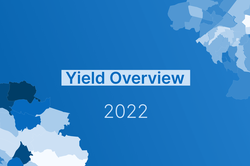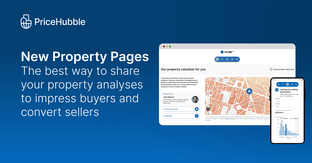This article looks at
- the price trend on the German real estate market,
- why investing in Berlin and Munich could pay off and
- how you can generate a realistic real estate valuation in just a few clicks.
Invest in Germany and look forward to substantial profits
In spite of the pandemic and weak GDP growth of only 0.6% as against 2019, real estate prices in Germany are still booming, with no end to this trend in sight, at least not for 2021, as Deutsche Bank confirms in its recent German Property Market Outlook 2021:
“The cycle is likely to remain intact in 2021 thanks to the low interest rate environment, fundamental supply shortage and current undervaluation,” says the macroeconomic expert from Deutsche Bank Research, Jochen Möbert.
Prices for both flats and houses rose throughout the year and were up by 11.46% by the first quarter of 2021. Prices for new builds rose by 7.51% year on year, while prices for existing homes climbed by 14.73%. Extremely low interest rates, with average interest rates for new housing loans of 1.17% as against 1.28% a year earlier and 1.78% two years ago, meant that the supply and demand gap continued to widen, according to Deutsche Bundesbank.
This trend is supported by increased state subsidies for bigger families in general, and by much simpler lending processes, particularly for families with children looking to build new homes.
So anyone investing in Germany can look forward to substantial profits. But does this theory hold true for every city in the country? Our article uses two examples in a quest to illustrate
- how complex the real estate market valuation process is,
- what factors are at play and
how PriceHubble’s Property Analyser can help you to generate a realistic real estate valuation in no time.
Invest in Munich, Berlin or Frankfurt am Main
Investing in a property in a major German city could well prove worthwhile in the long run, but the yields you can expect to generate vary from city to city.
According to a study published in April by the real estate portal Immowelt on the real estate market in Germany’s eleven largest cities, not all cities reported increasing prices.
Investing in Munich
Munich has been the undisputed leader of the real estate price league table for years now, with prices averaging EUR 8,552 per square metre. But has the city’s growth potential been exploited? The study would suggest not: Instead, prices in Munich are predicted to grow by as much as 11% to EUR 9,513 per square metre in the space of a year.
Investing in Frankfurt am Main
In the prosperous banking centre of Frankfurt am Main, on the other hand, which is currently Germany’s second most expensive city at EUR 5,462 per square metre, there is currently very little movement in prices. Prices are showing minimal upward and downward trends quarter on quarter, with no growth, but rather only a sideways trend, in a year-on-year comparison.
Investing in Berlin
Real estate prices in Berlin, on the other hand, are rising by more than 8% a year. Anyone making an investment now, at a comparatively low price of EUR 4,054 per square metre, could be set for substantial profits. So what are the arguments supporting this assessment?
Munich and Berlin – two cities in the spotlight
Despite prices already being at a high level, Munich is set for further growth. In Frankfurt am Main, despite prices here being lower than in Munich, stagnation would appear to be on the cards in the medium term. 30 years on after the Berlin Wall came down, prices in the German capital are still at an extremely low level, meaning that the city could be set to see the most pronounced price increases.
A whole number of factors have an impact on prices on the market. Let’s take a closer look at Munich and Berlin, the two markets that are currently showing a lot of movement.
The top three success factors that speak in Munich’s favour
1) Excellent educational opportunities
Munich, Germany’s third-largest city, is home to a large number of renowned museums and sights, as well as to Germany’s most prestigious universities, such as Ludwig-Maximilians-Universität or the Technical University of Munich. These world-class teaching centres ensure an ongoing influx of new students every semester. The high quality of life that the city has to offer (ranked 3rd out of 231 cities in Mercer’s Quality of Living City Ranking) and excellent job prospects motivate graduates to stay. This ensures stable and growing demand on the local real estate market, which is likely to continue to grow.
2) A strong economy
Germany is the world’s fourth-largest economy, and the south of the country is its economic hub. Most international companies choose Munich for their German headquarters, for example, Microsoft and Salesforce. Munich is also home to the headquarters of global players like Siemens and BMW. The surrounding area is peppered with German hidden champions. A stable economy and wages that are high in general – is there any better argument for a real estate market that is booming, with predicted growth of 11%?
3) Lifestyle
As already mentioned above, Munich is hard to top when it comes to quality of life. Munich has a milder climate than, say, Berlin with its continental climate, the Alps start in the city’s backyard, the surrounding countryside, with its numerous lakes, provides countless leisure opportunities and the city’s proximity to Austria, Switzerland, France and Italy automatically give it a multicultural vibe. Location really is everything – it ensures that anyone moving to Munich is motivated not only by their head, but also by their heart. This is another reason that makes growth likely. Incidentally, this also applies to the area bordering the city, which is gradually becoming increasingly popular among hip city-dwellers.
The top three success factors that speak in Berlin’s favour
1) The most affordable capital city in the world
Berlin is the administrative capital of the world’s fourth-largest economy. It is also the seventh-largest metropolitan area in the European Union. And yet despite that, one square metre in Berlin costs less than in the Hanseatic city of Hamburg. This is one of the reasons why young people, in particular, are moving to Berlin and injecting new energy into the local economy and culture.
This influx of people is having something of a pull effect. Berlin currently boasts a population of around 3.6 million and has been reporting average population growth of 5% over the last five years. According to the real estate service provider Jones Lang LaSalle, the city will, in theory, need around 18,500 new flats every year between now and 2030 to meet the massive shortage of housing that it currently faces. The fact that this demand is not being met makes Berlin a very affordable and promising real estate market from an investor point of view, with ample potential for growth:
Attractive entry prices, such as the low price per square metre, high value growth of around 13% at present and the fact that the rental cap was defeated in court this year send out a clear message.
2) Transport and infrastructure
Mobility is one of the key factors behind Berlin’s appeal. Direct flights connect the city with every European capital and most major European cities in only a few hours. There are links to every major German city as part of the ICE Sprinter high-speed rail network, and the public transport system, featuring S-Bahn suburban trains, the underground, bus and tram, is virtually unrivalled.
Berlin is considered the most environmentally friendly capital in Europe. This has motivated the city’s authorities to invest in an innovative system of cycle lanes. The city is also often used as the German testing ground for international mobility providers.
All of these factors are reflected in Berlin’s quality of life score (13th out of 231 cities evaluated in Mercer’s most recent Quality of Living City Ranking). Anyone who opts to invest now can benefit from a substantial profit margin compared to other major German cities.
3) Global start-up hub
Thanks to its low cost of living, high quality of life and excellent transport connections from a global perspective, Berlin is a magnet drawing young people, and with them innovation, into the city. While it might not be Silicon Valley, in European terms there is no other city that is better for start-ups than Berlin, which offers a whole number of subsidy programmes for people looking to launch their own businesses.
Numerous business incubators offer services to assist young entrepreneurs, the city is home to unicorns such as N26, Gorillas and GetYourGuide, as well as listed industry giants like Delivery Hero, Auto1 and Rocket Internet.
As future employers, these companies are helping to ensure that Berlin remains an attractive location on the global map.
Any real estate investment has to be weighed up on a case-by-case basis
Germany as a whole, and in particular the two cities of Munich and Berlin, are looking extremely attractive for real estate investors. A stable economy, entry prices that are low by global standards and rising demand technically promise secure yields in the long term.
Our article was only, however, able to look at the factors used to assess general market developments.
Any real estate investment has to be weighed up on a case-by-case basis. While overall market trends certainly have a role to play, it is generally much more important that the property in question offers good value for money in terms of its condition, quality and location, and that the micro-location offers attractive potential going forward.
This means that investors cannot rely on the macro data for a city, but have to examine each and every investment opportunity carefully to arrive at an assessment of its future potential. Incidentally, this also applies to investment opportunities in supposedly unattractive regions, which can, in some cases, turn out to make good investments after all.
Anyone who has ever tried to find the information and data they need to help them get an overall picture of a property’s yield and appreciation potential will realise how difficult this process can be. Data is often incomplete, or is not available at all. Purchase prices for neighbouring properties, for example, are kept under lock and key by expert committees and are only made available in isolated cases and in return for a fee. Professional valuations by real estate experts are costly and hardly the best option for arriving at a quick initial assessment of an investment opportunity.
PriceHubble is seeking to solve this problem. With Property Analyser, we provide a tool that bundles all of the information available on a specific micro-location and presents it in a clear and interactive manner. This includes:
- Current and past comparable properties in the area
- Socio-economic data on a micro level (e.g. for a particular district of the city)
- Local amenities (schools and nurseries, shops, doctors, leisure facilities, etc.)
- Accessibility analyses based on all relevant modes of transport (walking, cycling, car, public transport)
- Current and planned construction activity in the surrounding area
- And much more ...
All this data is ultimately processed by PriceHubble’s automated real estate valuation model (AVM), which calculates what are, statistically speaking, the most likely market prices and market rents, and how they look set to develop over time, based on the data made available for the property concerned. This combination of clearly presented data and analyses generated using artificial intelligence means that Property Analyser offers the ideal basis for investors’ decisions.







